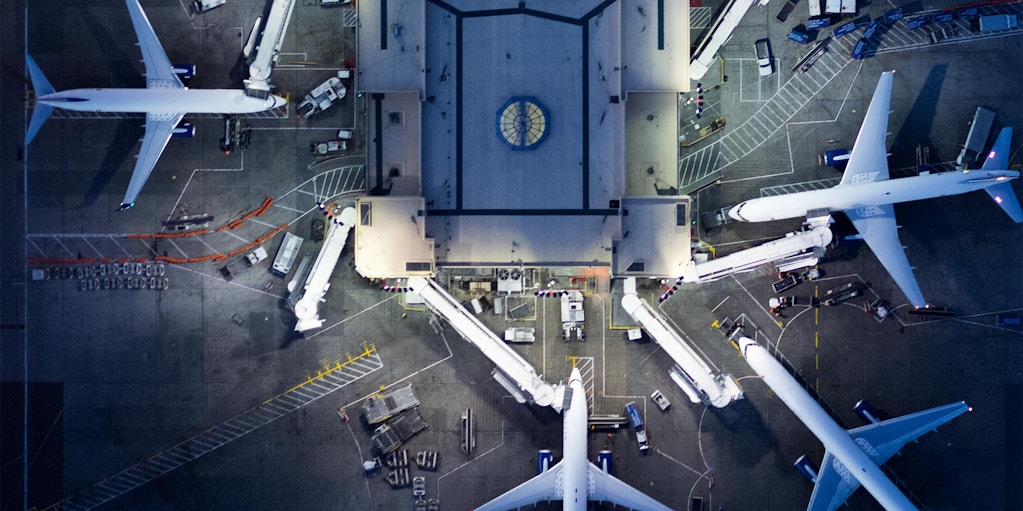
Why airports must embed AI into infrastructure to create a tailwind for growth
Tags
As global air passenger numbers rise, legacy infrastructure is holding airports back. Embedding AI offers a path to growth, but only with the right intelligent foundations to unify data and scale innovation.
In 2025, global air passenger numbers are set to pass five billion for the first time. The Federal Aviation Association (FAA) projects an upward swing across the industry, with major airport expansions and modernisation projects underway around the world. This growing investment underlines the crucial role that air travel plays in driving economic development and supporting broader connectivity across the transport landscape.
However, a major challenge to this growth is ageing, maintenance-hungry, and siloed infrastructure within the world’s busiest transport hubs. Legacy systems and processes are leaving airports struggling to handle growing passenger demand and flight activity, which can dent their competitiveness and profitability. If this isn’t addressed, airlines and passengers will simply choose more responsive competitor airports.
In this high-stakes situation, embedding new technologies, such as AI, into existing infrastructure is increasingly offering airports a way to introduce innovations to support growing passenger numbers. But to do this at scale, airports need intelligent foundations: a unified, AI-ready approach that brings together data, applications, and strategy across the ecosystem.
Build intelligent foundations to unlock airport AI
AI cannot thrive without strong underlying foundations. Instead of relying on disconnected legacy systems, airports need to focus on building a coordinated, intelligent platform where data and applications work together seamlessly. The cornerstone of this approach is establishing a holistic data strategy. This involves identifying, connecting, and governing all critical operational data sources across the airport, including air traffic control, gate management, baggage and maintenance systems, passenger flows, and commercial operations. With this approach, airports can create a comprehensive, trustworthy view of real-time activity, breaking down data silos and laying the groundwork for powerful AI applications.
While there are clear benefits to a holistic data strategy, it requires advanced integration capabilities with experienced teams and ongoing support, underpinned by strong change management. In addition to a challenging legacy environment and (often) a lack of in-house capacity, airports prioritise to ensuring current levels of operational continuity.
Without a robust data foundation, airports increase the risk of deploying AI ‘point solutions’, which create imprecise and underperforming outcomes while tying up scarce resources, creating additional operational risk, and decreasing trust from key ecosystem partners.
Target impact, measure results, and scale with confidence
The value of AI begins with understanding where it can deliver the greatest impact. It is essential for airport leaders to identify high-value operational areas, such as aircraft turnaround or passenger flow, and to assess their existing capabilities in both technology and people before embarking on their AI journey. Establishing a clear framework for evaluation from the outset allows airports to align their metrics with what matters most to their strategy. This ensures that AI initiatives drive genuine operational value, rather than becoming stuck in perpetual pilot stages.
Once a use case is selected, this is when airports should develop a clear evaluation framework. This enables leaders to measure the real operational impact using metrics such as on-time performance, passenger dwell times, and commercial revenue. These insights can then inform and refine strategies, ensuring effective scaling of AI across the airport.
For example, by partnering with another global airport, we used a blend of data and AI to address the persistent issue of late-boarding passengers. Through a Dynamic Call-to-Gate solution, passenger data is used to manage the flow from lounge to gate, preventing bottlenecks and mitigating risks associated with overcrowding. Each part of the solution is measured, from numbers of passengers in specific areas, to reductions in delay, to links between retail revenue and passenger movements. This demonstrates how when built on intelligent foundations, AI’s contribution is visible and defensible.
Unlock advanced and autonomous AI capabilities
On top of these unified data foundations, airports can more effectively leverage AI technologies, including agentic AI systems. By deploying digital solutions that use this single source of truth, airports can enable AI agents to semi-autonomously or even autonomously analyse data, coordinate responses, and optimise optimise operations across daily functions and strategic transformation.
Bringing this to life, we are currently supporting a number of airports in modernising their Airport Operational Databases (AODB). Instead of acting purely as passive record-keeping systems, these next-generation AODBs are being designed to consolidate and harmonise information from a wide array of existing sources, including flight schedules, resource allocation, and passenger and baggage data. This creates high-quality, real-time input that AI systems need to deliver relevant, actionable insights. Importantly, this does not require a complete rebuild; practical approaches such as modular upgrades, middleware solutions, and data integration layers allow AI to work alongside existing legacy systems, enabling airports to gain immediate value from their current technological investments while minimising disruption.
Other advanced AI use cases quickly become possible once intelligent foundations are established. These use cases increase visibility across all airport functions, drive closer collaboration, and ensure the efficiency is additive across the whole passenger journey. Live CCTV and sensor feeds can be analysed to monitor and predict passenger congestion and streamline queue management, reducing delays. When AI is applied to equipment and maintenance logs, airports can anticipate breakdowns in key systems, such as baggage handling or air conditioning, making proactive intervention possible and avoiding operational disruptions.
Take aircraft turnaround as another example. This process involves the coordinated movement of baggage, refuelling, catering, and cleaning teams. Delays in turnaround are a significant contributor to missed slots. In collaboration with airports, such as Amsterdam Airport Schiphol, we have supported the development of solutions such as Deep Turnaround, an AI-driven tool that brings together a variety of data sources to monitor and predict turnaround performance. Based on implementations so far, this has uncovered the potential to reduce last-minute gate changes, a leading cause of delays, by as much as 50 percent.
Build trust by emphasising the human element
Deployment of AI in itself is not the end, but a means to the end – a better airport experience. To ensure that benefits are achieved and true integration in operations is achieved, airports need to ensure a robust approach to building trust, upskilling and empowering employees, and creating a structured approach to change management.
Confidence is vital to adopting AI, and a key part of that is trust. Airports need to deploy AI in a transparent way that underlines that the technology enhances human judgement. This means being explicit about where AI’s role in a process begins and ends, and how and where humans can override it, especially in safety-critical roles across the operations.
Teams become more confident when they can see they’re an essential part of helping AI succeed, and how AI makes them better at their own jobs. Clear accountability also breeds confidence among key stakeholders such as regulators, customers, and passengers, and that bolsters the airport’s reputation.
A useful parallel can be found in our recent experience working with Eurostar to harness AI to improve operational performance and the passenger experience. By developing a predictive model using existing data, including customer check-ins and train service performance, Eurostar was able to anticipate and manage delays and congestion, boosting reliability without collecting new data or overhauling existing systems. Importantly, the approach ensured that human teams remained integral to the process. Operational staff worked closely with data scientists, testing the model and building in clear mechanisms for human oversight and intervention.
This collaborative method both empowered Eurostar’s staff and enhanced trust in the technology, demonstrating that AI can strengthen, rather than replace, human judgement within complex, safety-critical transport environments. It highlights how transparent deployment and team involvement are critical for success, providing a blueprint for building confidence and accountability around AI innovation.
Empower people, build capability, and manage the change
Realising the full value of AI in airports relies not just on technology, but on developing the skills and confidence of the people who use it every day. With airport staffing still recovering in many locations, and competition for specialist AI talent remaining strong, airports must focus on upskilling their current workforce. The most effective adoption happens when airport teams, such as operations controllers, ground handling staff, security supervisors, and maintenance engineers, are empowered through tailored training that fits around their demanding schedules.
For example, airports are now using digital twins and operational simulation tools as hands-on training environments. This allows terminal staff to practise responding to AI-generated insights, such as optimised stand allocation, baggage flow alerts, or predictive maintenance interventions, in a safe, controlled setting. Security teams, for instance, can learn how to interpret and act on AI-driven passenger flow forecasts, helping them to reroute resources during busy periods before bottlenecks occur. Ground operations might use AI-enabled tools to dynamically reschedule equipment or workforce in response to real-time flight changes, directly improving turnaround times and on-time performance.
A structured approach to change management is vital to this success. By rolling out phased, role-specific training, airports can ensure that staff at all levels, from frontline agents to operational planners, are equipped to adopt AI-enabled tools with confidence. This not only supports smoother uptake and efficient workflows but makes it possible for airports to innovate continually and respond to new challenges far more resiliently.
For airport technology leaders, the next chapter is clear
Investing in ‘point solutions’ and siloed applications lead airports towards an environment where operational inefficiencies increase, barriers to collaboration are erected, and visibility across all airports functions becomes opaque. This makes it harder to adapt to changing demands quickly and leaves the full potential of advanced technologies like AI unrealised.
Laying the intelligent foundations now is essential. When data, systems, and applications are properly connected, airports are better positioned to standardise where possible and customise where needed. This flexibility enables long-term improvements through AI in safety, operational efficiency, revenue generation, and customer experience, while future-proofing the airport against the evolving demands of 24/7 global aviation.
Invest in intelligent foundations. Integrate your data and applications. Prioritise transparency, skills, and measurable outcomes. Empower your people. With this in place, AI can help transform an airport into a safer, more efficient, and more attractive hub for all.
Explore more












